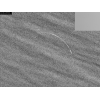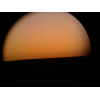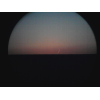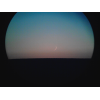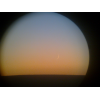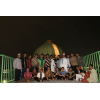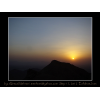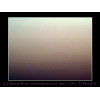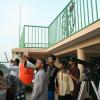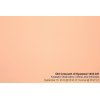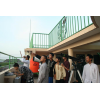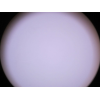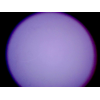Visibility of Dhul Qeadah Crescent 1433 AH
- When to Observe Dhul Qeadah Waxing (NEW) Crescent ?
- Dhul Qeadah Waxing (NEW) Crescent Observation Results
- The OFFICIAL First Day in Different Countries
- When to Observe Shawwal Waning (OLD) Crescent ?
- Shawwal Waning (OLD) Crescent Observation Results
When to Observe Dhul Qeadah Waxing (NEW) Crescent ?
The geocentric conjunction (Geocentric New Moon) will occur Inshalla on (Sunday 16 September 2012) at 02:11 UT.
Sighting the new crescent on (Sunday 16 September 2012) and (Monday 17 September 2012) is shown in the below graphs using the program Accurate Times by Mohammad Odeh according to Odeh criterion. Where:-
- It is impossible to see the crescent from the areas located under the red color. Because either the Moon on this day sets before the Sunset and/or the topocentric conjunction occurs after the Sunset.
- The crescent is expected to be seen by optical aid only from the areas located under the blue color.
- The crescent is expected to be seen by optical aid from the areas located under the magenta color. In these areas the crescent could be seen by naked eye if the atmospheric conditions are superb and the observer is experienced.
- The crescent is expected to be easily visible by naked eye from the areas located under the green color.
- The crescent cannot be seen from uncolored areas, even though the Moon sets in these locations after the Sunset and the topocentric conjunction occurs before the Sunset, but the Moon is not sufficiently illuminated in order to be seen as crescent even by optical aid.
- Kindly notice that the below graph shows the possibility of seeing the crescent from areas between 60 degrees north of Equator down to 60 degrees south of Equator.


According to the Universal Hejric Calendar (UHC), which is based on the calculated crescent visibility, the start of this month in the Eastern Region will be on Monday 17 September 2012 and in the Western Region will be on Monday 17 September 2012. Kindly notice that the UHC is a pre-calculated calendar, which adopts a certain criterion to start the new Hejric month. Your country/organization might adopt different criterion to start the new Hejric month. So it is highly advised to read the UHC website before giving any judgment.
- Results of seeing the crescent, and the first day of the month in different countries will be added here Inshalla as we receive the reports from ICOP's members. If you wish to be a member in ICOP, or to know more about it, kindly click here.
Dhul Qeadah Waxing (NEW) Crescent Observation Results
Sun 16 September 2012
Germany
Eng. Martin Elsaesser said: "The day after conjunction started with fog. After the fog had resolved skies were ok, blueish but with areas of haze moving around. I was to lazy to leave the house, so i setup the instruments in the garden. As the moon would set before the sun, i had to do daytime observation again. I searched for and found the crescent with the imaging system around 15:00 (UT+2), visible as 90° arc at 8° elongation. I will try to follow the crescent through the afternoon. The automatic processing software did all the work, i just had to bring the crescent arc in the field of view."
Ghana
Mr. Abdul-Aziz Anyang said: "The new Crescent for Zul Qad was not seen though we have a very clear weather after sunset."
Malaysia
Nigeria
Mr. Simwal Jibril said: "It was raining through out the day, the weather was not clear at all."
Mr. Yunusa Yakubu said: "the weather condition was cloudy the sun was out of sight an hour before setting time."
Saudi Arabia
South Africa
United Kingdom
Eng. Qamar Uddin said: "On Sunday, 16 September 2012 (29 Shawwal 1433 AH) many people from throughout UK have attempted to sight the crescent moon (Hilal) of Dhul Qa'dah after sunset. None of the groups were able to sight the Hilal, even though some places had clear sky conditions. We have not received any reliable sighting reports (Muhaqaq-Ruyat-Basari) from the east of UK/Morocco either. Therefore, the Wifaq/Batley Ulama have decided that the month of Shawwal 1433 AH will complete 30-days and the month of Dhul Qa'dah 1433 AH will start from Tuesday 18 September 2012, Insha-Allah. "
United States
Mr. Jim Stamm said: "New Moon Crescent Observation Report ====================================== Observed: Sunday; September 16, 2012 - 18:23 (Local) Location (WGS 84) = Tucson, Arizona (USA) Longitude = 110.9651 W Latitude = 32.4206 N Elevation = 842 meters Time Zone = -7.0 hours Surface conditions at location: Temperature = 15 °C Humidity = 54 % Pressure = 29.96 in. Only slight haze, and a little darkening on the western horizon kept the sky from being perfect. Topocentric and local time values from “Accurate Times”: Sunset (at sea level) = 18:32 Moonset (at sea level) = 18:47 Time from new moon at 18:23 = 22 hr. 21 min. Moon lag time = 15 min. Relative Altitude = 3.1 degrees Elongation from sun = 13.3 degrees Crescent width = 26 arc seconds Illumination = 1.4 percent I was NOT able to see the crescent, even through a telescope. The color through the eyepiece looked good, and I thought, “Just one more minute .... Observer: Jim Stamm E-mail Address: StammJim@gmail.com"
Mon 17 September 2012
Algeria
Mr. Hocine Chikh Aissa said: "Rarely whene we seen the new crescent From sunset to Moonset, This is what happened with The Dul Kida 1433 from N'tissa station in Ghardaia South Algeria uesd two binoculars (07x50). The western horizon was Clear. The atmospheric condition (haze) near the western horizon was Superb, first seen by naked eyes was at 18:45."
Ghana
Mr. Abdul-Aziz Anyang said: "New crescent was clearly seen with no difficulty as weather conditions was perfectly okay. "
Indonesia
Mr. AR Sugeng Riyadi said: "On Monday, September 17, 2012 The New Crescent of Dzulqodah 1433 AH was very easily seen from Assalaam Observatory, The Islamic Modern Boarding School of ASSALAAM, Surakarta Indonesia. According to the Imkan Rukyah Criterion, the first of dzulqo'dah in Indonesia was began on Monday, September 17, 2012."
Iran
Mr. Alireza Mehrani said: "Location: Sofe Mount, Esfahan , Iran Latitude: 32° 35' 26.59" N Longitude: 51° 38' 11.78" E Elevation: 2070 meters from sea level Time zone: +4.5 Observer & photographer: Alireza Mehrani Date: Monday September 17, 2012 (Shahrivar 27, 1391) Topocentric and local time values from "Moon Calculator" (Refrac off): Crescent first observation through 7x50 binoculars: Time: 19:04 (14:34 UT) Moon Alt: 7° 02' 00" Sun Alt: - (0° 15' 48") Elongation: 20° 10' 48" Rel Azi: - (18° 51' 39") Moon Width: 1.00' Moon Phase: 3.19% Moon Age: 36h 24m after conjunction Crescent last observation through 7x35 binoculars: Time: 19:27 (14:57 UT) Moon Alt: 2° 28' 07" "
Nigeria
Dr. Z.Sani Mustapha said: "The new moon was seen at 6.50 pm after magrib prayer"
Mr. Yunusa Yakubu said: "the new crescent was sighted by me at 18:30.and many other people from different places within and out side Bauchi town and Bauchi state through our contacts"
Oman
Prof. Mohammed Al-Bussaidi said: "The sky was very dusty and hazy as such we could not see the Sun half an hour before it set. We tried to see the crescent first i the morning time using special crescent telescope and also in the evening time and in both times we could not see the crescent."
Pakistan
Mr. Alam Sultan said: "Today (Monday, September 17, 2012 = 29 Shawwal 1433 in Pakistan), members of Jamia-tur-Rasheed tried to sight the moon at more than 40 places. Almost it was cloudy, rainy or hazy country wide. Only 5 places were clear. The moon was not seen. Officially announced that moon was not sighted hence it is 30th Shawwal on Tuesday and 1st Zul-Qa’dah 1433 is on Wednesday, September 19, 2012. Note: Tuesday, October 16, 2012 would be 28th Zul-qa’dah 1433 in Pakistan and there is a possibility……although very slim……to sight the moon on that day. May Allah save us from any inappropriate situation. "
Saudi Arabia
The OFFICIAL First Day in Different Countries
Mon 17 September 2012
1 . Indonesia
2 . Malaysia
3 . Nigeria
4 . Saudi Arabia
Tue 18 September 2012
1 . Ghana
2 . Iran
3 . Oman
4 . South Africa
5 . United Kingdom
Wed 19 September 2012
1 . Pakistan
When to Observe Shawwal Waning (OLD) Crescent ?
The geocentric conjunction (Geocentric New Moon) will occur Inshalla on (Sunday 16 September 2012) at 02:11 UT.
Sighting the OLD crescent on (Sunday 16 September 2012) and on (Saturday 15 September 2012) is shown in the below graphs using the program Accurate Times by Mohammad Odeh according to Odeh criterion. Where:-
- It is impossible to see the OLD crescent from the areas located under the red color. Because either the Moon on this day rises after the Sunrise and/or the topocentric conjunction occurs before the Sunrise.
- The crescent is expected to be seen by optical aid only from the areas located under the blue color.
- The crescent is expected to be seen by optical aid from the areas located under the magenta color.. In these areas the crescent could be seen by naked eye if the atmospheric conditions are superb and the observer is experienced.
- The crescent is expected to be easily visible by naked eye from the areas located under the green color.
- The crescent cannot be seen from uncolored areas, even though the Moon rises in these locations before the Sunrise and the topocentric conjunction occurs after the Sunrise, but the Moon is not sufficiently illuminated in order to be seen as crescent even by optical aid.
- Kindly notice that the below graph shows the possibility of seeing the crescent from areas between 60 degrees north of Equator down to 60 degrees south of Equator.
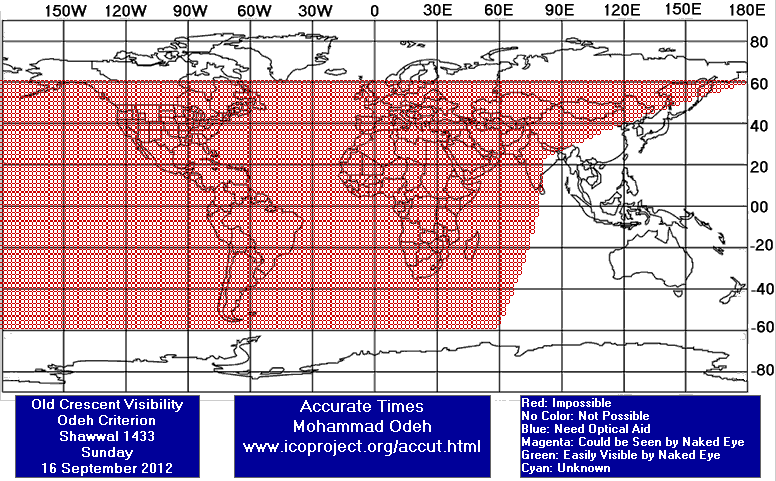
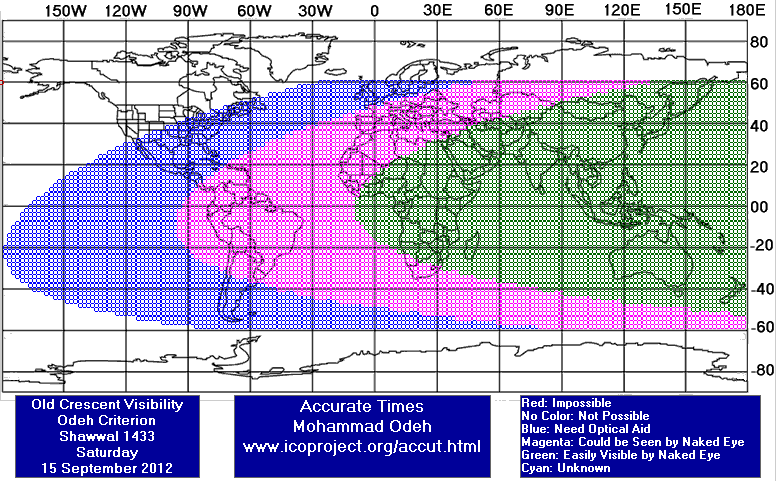
Shawwal Waning (OLD) Crescent Observation Results
Sat 15 September 2012
Indonesia
Mr. AR Sugeng Riyadi said: "The old crescent of shawwal 1433 AH was very easily seen by my students at Assalaam Observatory, The Modern Boarding School of Islam ASSALAAM Surakarta Central Java Indonesia. It also seen from my foreyard at Juwiring Klaten Central Indonesia."
Iran
Eng. Reza Jamali said: "The crescent photo was taken by Canon Camera A1200IS by 127mm maksutov telescope and 50mm eyepiece in afocal method at 11:15 am(+4:30 GMT Iran Summer Time) http://estehlalfars.blogfa.com/post/111"
